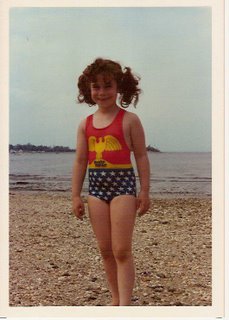
This was the cover of All Star Comics #8, from December 1941. The comic featured Wonder Woman's first appearance. You will notice that Wonder Woman does not appear on the cover. She's not even
mentioned on the cover. She got eight pages of story that were buried in the back of the comic. That's apparently because the Justice Society hates women. Here, the metaphorical "glass ceiling" in their organization is represented by The Specter's stupid crystal ball, which would have Wonder Woman revealed trapped within, if not for the ultra-lame Dr. Mid-Nite and Starman appearing in a fog of their own disdain for anything with a vagina.

8 months later, she ended up joining the Justice Society. She was easily the strongest member of this line-up of superheroes, so, naturally, she became the team's secretary.

Aside from the honour of getting the last billing in every issue, she got to read exciting letters about the boys' adventures. Her other duties included making coffee, laughing at the other members' jokes, and, of course, daily blow jobs.


The cover of Sensation Comics #1 was taken from Wonder Woman's first appearance in All Star Comics #8. This was during comics' "Golden Age" that took place from 1938-1954 (I have read many comics from that era, and can only assume that the name was intended as ironic). Notice the (relatively) modest skirt that she is wearing. This was common among heroines of the Golden Age, like Mary Marvel (right) and... um ... Mary Marvel (right) and other heroines like... um... uh...
Okay, so there weren't many heroines in comics at that time. So sue me.

In the summer of 1942, Wonder Woman became the first woman to star in her own serialized adventure comic book. I understand that this is what counted as a great step forward for women in 1942. It's easy to make fun of the sexism in comics of this time, but it should be noted that they really were trying to present a positive image for women to aspire to. Alongside William (inventor of the lie detector test (no, really (and, yes, that
is related to why Wonder Woman had the power to make people tell the truth))) Marston's stories of Wonder Woman's adventures were comics that Alice Marble wrote about actual heroic women throughout history. So, say what you will about the psychosexual subtext, it really was a feminist comic.
Among the indignities that Wonder Woman had to suffer in order to get her own comic was the removal of her skirt in favour of a similarly patterned pair of short shorts.


By the premier of her new series in 1987, even the shorts were gone leaving only her underwear. Thus, flipping through Wonder Woman covers is sort of like the world's slowest strip-tease. (Eventually, it becomes worth it (right).) In this version of her costume, the eagle on her breast was replaced with the letters "WW," in case she forgot her initials. We can only speculate as to whether she ever turned it upside down and lent it to Mary Marvel.

Many have noticed the similarity in design between Wonder Woman's outfit and the American Flag (left). Others have noticed other subtle references to her national identity, such as her working for the United States government and busting the heads of dirty Krauts alongside the United States Army. This is a bit odd, considering that Wonder Woman isn't really an American at all. In All Star Comics #8, Wonder Woman's home was on Paradise Island, a small island in the Bahamas. Paradise Island was once known as "Hog Island," but I think the new name probably attracts more tourists. When Wonder Woman's origin was rewritten in the 80's, her home was identified as Themiscyra, the capital city of the Amazon tribe, which was located on the Terme River in northern Turkey. Interestingly enough, in the comic, this Eastern European city was located somewhere in the Bermuda Triangle, because aside from really sucking at physics, D.C. comics writers were apparently also not too keen on geography.
Themiscyra no longer exists, if it ever actually did exist (Greek histories claim it did, but they also believed in snake-haired women who could turn you into stone on sight, so some of their accounts have to be taken with a grain of salt). Herodotus said that after the Amazons' defeat at the battle of Thermodon (Oh, does that make you feel like big men, Greeks? Beating up a bunch of women? You ought to be ashamed of yourselves!), the Amazons fled to the Russian Steppes, where they took their husbands from the Scythians, which was the origin of the Sauromatian culture. (As a side note, some maintain that the Scythians are philologically related to the Ashkenazi Jews. I mention this only because Ashkenazi has got to be the funniest name for an ethnic group I have ever heard.) There is archaeological evidence of the Sauromatians, and that they did indeed have warrior women, but they were conquered by the Mongols around 370 AD. Some anthropologists believe that
there is genetic evidence among Mongolians that indicates their Amazon origin.

I wasn't particularly interested in the genealogical details of Amazons until I saw one episode of the cartoon series
The Justice League, in which the League fights Amazon warriors on Themiscyra and I noticed that one of them was black. At first I thought this was an error, like the
black Viking in
The Norseman, but I did a bit of research to make sure. I found out that there was a group called the "Dahomey Amazons" in Africa, who were completely unrelated to the Turkish Amazons, except that they had warrior women. Also, I found out that Wonder Woman had a long-lost black sister named Nubia. The origin (above right) goes that Hippolyta, queen of the Amazons, had made two figures out of clay, one black and one white. I haven't read the whole comic, but I think she was trying to make a set of novelty salt and pepper shakers, but misread the scale, so she decided instead to have Aphrodite bring them to life. Nubia was then kidnapped by Mars (who apparently didn't realize that he was from a different mythology) who trained her to be a warrior. Nubia is usually seen as Wonder Woman's enemy, but they do have their playful moments, like when they were in the local production of
Rebel Without a Cause together (below).




























 The Wonder Woman cami and panty set is a cozy and economical way to develop a Wonder Woman-like appearance. Buying it
The Wonder Woman cami and panty set is a cozy and economical way to develop a Wonder Woman-like appearance. Buying it 